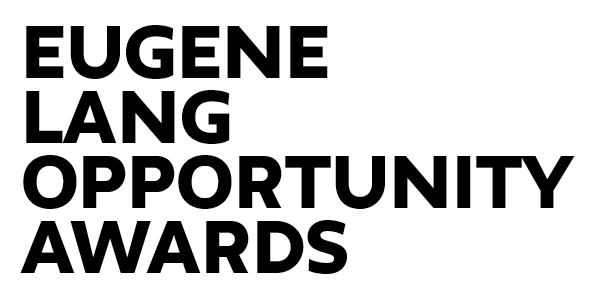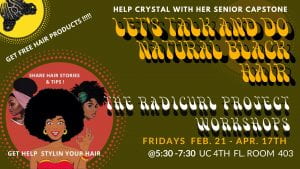Origins
My name is Crystal Ellington. I am a black first-generation college student who majored in culture and media and minored in sociology as well as race and ethnicity. For my senior capstone project, which I named The Radicurl Project, I ultimately decided to explore the significance of contemporary black hairstyles and hair care on a personal, social, and historical level.
However, the project’s vision did not begin with either of the notions listed above. The original proposal that I submitted to my thesis advisor Orville Lee was an exploration of self-confidence, hair, and identity. This was due to my opinion that the current black gaze within American is too heavily influenced by the white gaze, which is why black women still feel uncomfortable wearing their natural hair, and there is so little knowledge passed down from mothers about natural hair care. But as I learned more about black hair history and opinions, my project evolved into an exploration of black beauty and the current hair care practices within America’s black community by personal and communal reflection.
Phase 1
During the Fall 2019 semester, which is noted as Phase 1 of the project, I planned to:
- gather research materials to support current hair care practices
- explore the various ways black hair affects identity
- find black women to interview on campus for their opinion on natural hair, black beauty, the white gaze, and personal hair stories to create a dialogue of reflection and introspection.
The women interviewed came together each week for The Radicurl Project Workshops, sessions that encourage discussions on hair, beauty, and texturism amongst women of the black diaspora. The women were asked to complete a 30-day challenge of wearing and styling their own natural hair while logging the process into their hair journal. To encourage participation in the sessions, funds from my CESJ mini-grant were used to purchase snacks and hair products that could be used home and discussed in the space.
As I started doing research and conducting Phase 1’s workshops, my exploration began to shift into social practice, specifically socially engaged art. Socially engaged art is social interaction functioning to facilitate and maintain community through forms of participatory art. Usually, the art addresses social issues. By reading Hair Story by Aryana Byrd and Lori. L Tharps, I realized little knowledge from mothers about natural hair care is most likely a result of the slave trade and the black reconstruction era’s notions of presentable black bodies. The social issue that became apparent for my project was then the epistemology of natural hair care for a black woman due to the slave trade in addition to as the representation of the black woman in media because of colorism, texturism, and featurism. During this phase, the dialogue within the workshops was the art itself.
Phase 2
The original plan for Phase 2 included:
- focusing on the envisionment of The Radicurl Project beyond the original collective and myself
- hosting the 30-day challenge created for the workshops on social media.
- creating A website and Instagram to bring awareness of black hair history and the project itself
- a personal reflection paper
- potentially a mock magazine detailing workshops, natural hairstyles, and interviews/members of the collective.
While this was the goal, everything shifted in Phase 2. All participants of Phase 1 did not fully commit to the 30-day challenge of wearing their hair natural. So, the 30-day challenge was scrapped for Phase 2.
Instead of the challenge, we would commit to doing out hair in the space to help one another learn additional styling options, as a result of noticing black women with natural hair wanting styles beyond, afros and buns and skillset in braiding. This change ensured excitement for returning participants and new participants who already developed their hair regimes.
Since I recorded the workshops manually during Phase 1, I decided to film the workshops in this phase for easier documentation and to practice filming interviews. To ensure I had enough film equipment, research materials, and hair products for each participant, I requested funds from Eugene Lang Opportunity Award. I was lucky enough to secure funding, and I attempted to hit the ground running with a film assistant.
As we progressed into the more artsy and communal aspects of the workshops, Spring Break approached and, of course, COVID-19. Once we finally decided on braided hair as our first in-session hair care, we were no longer in the space, separated by state lines, and facing more stress and confusion than we could ever imagine. To give everyone space to process the changes, I canceled our upcoming session to go along with the school policy of no classes for the following weeks.
I felt devastated because I was off track more than I expected, without a website, enough footage, and nothing to show for the focal point of the sessions, doing hair together. I couldn’t fathom how we could do hair without physically being near each other.
Luckily, Natalie from CESJ helped me think the obstacle through by suggesting Zoom as our online community and while watching hair tutorials as in session hair care. Theses ideas went against my purpose for the workshops. I believe part of the reason for little natural hair knowledge is small or nonexistent physical communities to learn about natural hair in comparison to online communities, which can open the doors for false hair expectations. But of course, I embraced the idea. (Why? Because embracing and adapting to change is all a person can do. )
I looked forward to implementing the idea in the final sessions, but with the number of changes participants were facing in their lives, hair and my sessions were not a priority. I should have known this. In the global pandemic as a college student, hair is not on ones’ mind: instead, graduation, passing classes, food, money, and housing is. My hair wasn’t even on my mind, and this is my thesis project.
The products and objects I had for self-care were left in New York since I went home for spring break and packed for a short trip. My anxiety had resurged, and I rarely touched my hair or wanted to look in the mirror.
On Zoom, some were in the same boat me. We didn’t want to do our hair, and we didn’t know what to do with our hair. But we all knew we better figure something out because the longer we did nothing, the more work we would have to put in to get our hair back to itself. Others were fairing well, ensuring their hair was moisturized and protected at night. (Kudos to them!)
To help everyone out, no matter where they were with the relationship of their hair, I sent hair products or Venmo participants money to make up for products they didn’t receive because we never returned to school to do our hair together. Due to everyone being on different pages with their hair, the group decided to scrap the idea of youtube tutorials for doing our hair on Zoom for the #DontRushChallenge. The challenge ended up being a great mood booster since no one had dressed up and gone out for a month. Additionally, the challenge fostered community and sisterhood since we all styled our “after look” during the Zoom session while talking about the pandemic, our hopes for the future, and hopes for the black community.
Overall, the project has made me see our much community and history impacts how we see ourselves and care for our bodies, especially in unfamiliar territory. While I experienced a roller coaster’s worth of challenges, COVID-19, anxiety, conducting interviews on Zoom, filming, styling hair in the sessions, I would love to continue the project post-graduation. I got to discuss our sentiments on black culture, which helped me see how personal and social black hair care and black beauty is and widen my circle of friends along the way.
For more updates on the project, check out theradicurlproject.com.
And follow: @theradicurlproject to see the #DontRushChallenge

